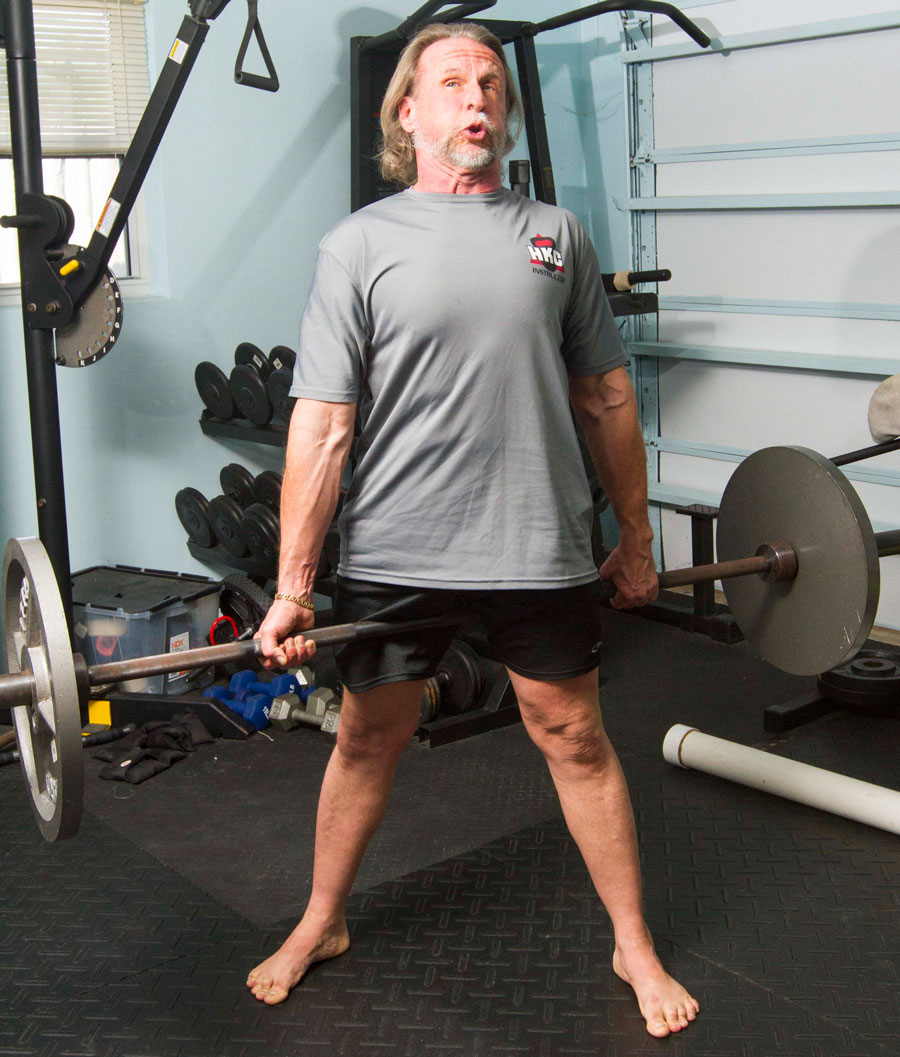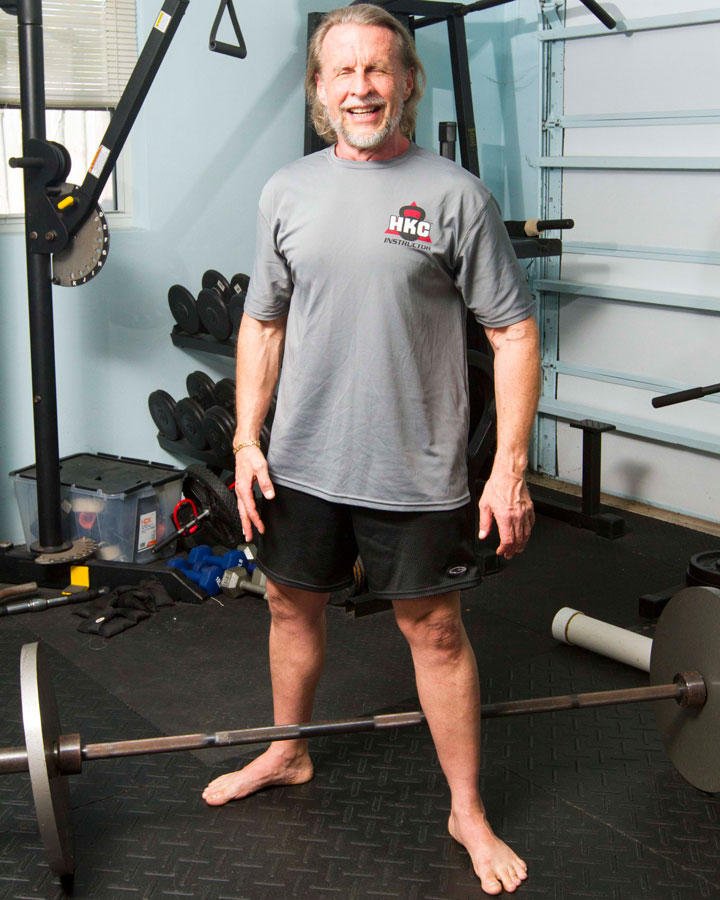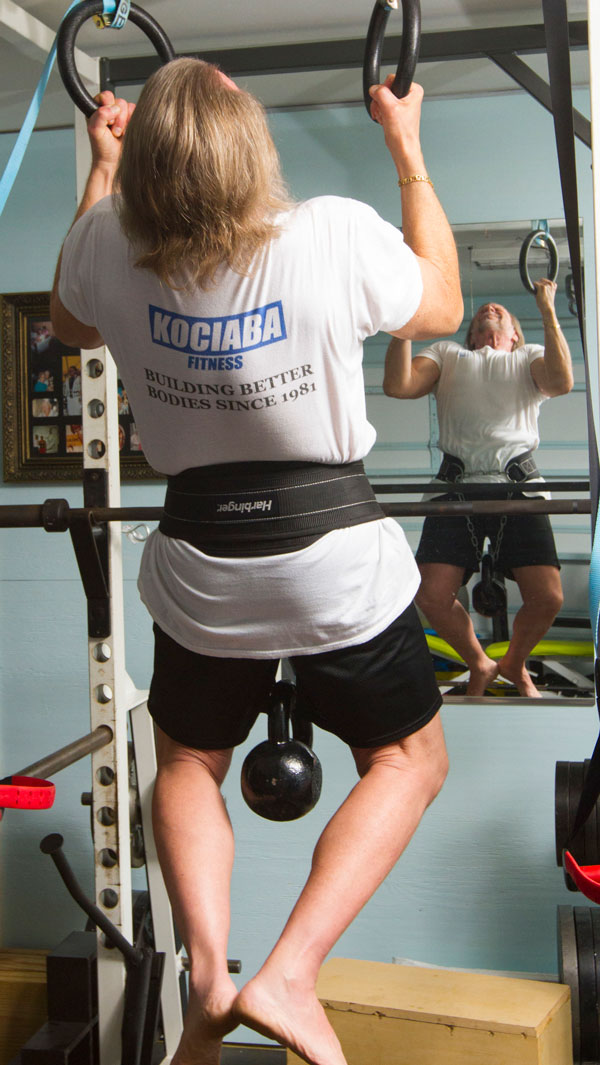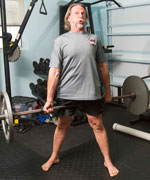Accidental Easy Strength
By Bill Kociaba, HKC and ACE Certified Personal Trainer

For the past several months I had been training in preparation for my
HKC with laser-like focus. My training was nothing but swings, get-ups and goblet squats. But I missed my old friends the military press and the deadlift. I decided that it was time for what Dan John calls "park bench" workouts. It was time to just go play in the gym, to train with no specific purpose beyond the joy of lifting heavy stuff.
I was intrigued by a mostly forgotten exercise called the "Jefferson Lift", sometimes referred to as the Jefferson Deadlift (JDL)*. I first saw it in the instruction manual for my first set of weights I purchased at Sears nearly 45 years ago! More recently, I stumbled across the Jefferson Lift again on a list of
deadlift variations. The movement is performed by pulling the bar from the floor while straddling it. One foot is in front of the bar, and the other foot is behind it.
My goal was simple: learn the lift, practice the lift, and master the lift—everything else in my training sessions would just be frosting on the cake. I planned to stick with this plan until an upcoming vacation. Nine weeks should be enough time to decide if the JDL would be a permanent addition to my training.
I planned to lift on three non-consecutive days. Each lifting session would include swings to warm up, an overhead pressing movement, the aforementioned JDL, and whatever else I felt like including on that particular day. Inspired by Pavel’s "Greasing the Groove" technique, I planned to do a few easy sets of the JDL on my "off" days just to reinforce the new movement pattern. But, it only took two "off day" workouts to recognize that even with light weights the JDL is no fun if you don’t warm up your hips and back first.

After I added a few
swings before the JDLs and did all the sets at one time instead of spaced throughout the day, a light went on. It all finally made sense. Until then I hadn’t been able to wrap my head around what Dan John had been trying to explain.
"Easy Strength" is about practicing and perfecting movement patterns with light weights to maintain excellent form—and only doing enough work to stimulate the body without overtraining.
After three weeks into my new training strategy I recognized the fact that my little loosely-planned program had morphed into "Easy Strength".
Here’s an example of a workout early in my program:
- Kettlebell swings 50 reps**
- JDL 2 sets of 5 reps left foot lead, then same on right
- Kettlebell press 3 or 4 sets of 3 reps, left and right
- Ab wheel 2-3 sets of 5
- TRX rows 1 set max reps
I quickly realized that doing two different movements that required double the suggested volume of work was just too much. Both the kettlebell press and the JDL have to be counted as double as each side is worked separately. I dropped the kettlebell press in favor of barbell military presses and called Dan with my dilemma. He agreed that I was trying to do too much total volume in the workout and concluded that I should treat the JDL as two movements: a left foot lead Jefferson lift and a right foot lead Jefferson lift.
A key point of
Easy Strength is doing
five movements: a hinge, a pull, a push, a squat and something else. The JDL hits three out of five movements. It’s a pull and a hinge for sure, but because it requires a lot more quadricep involvement than a conventional deadlift, it also can be considered a squat!
For weeks three and four, I employed the "same but different" method to the JDL by adding "fat grips" and standing on a couple of mats to effectively lower the bar about two inches. The Fat Grips solved an issue I was having because of the relatively light weight. Since I had to focus on crushing the Fat Grips, I could maintain the tension in my upper body since the tension from my hands spread through my traps, shoulders, and even helped keep my lats engaged.
After a truly horrible performance on the military press on the heavy day of week four—I was doing six progressively heavier singles—I changed the sequence of movements to press before deadlift. The change not only improved my focus on the press but also had the added bonus of making it easier to lock down my upper body during the JDL.
By week five, I was able to easily deadlift 20lb more than my top single from week two. Even more importantly, I was handling 40-50lb more on my light days than when I started my program.
Now, my workout had evolved:
- Kettlebell swings
- Barbell military press
- JDL left foot lead alternated with
- JDL right foot lead
- Pullups
At the completion of the program, I took a full week off from training—if you can call a vacation with a pair of 11 year old and 8 year old boys a week off. Then I decided to do the whole program again.
For the first four weeks I switched to a wide grip military press and a conventional deadlift. For the second half of the program I switched to a normal grip press and the Jefferson lift. By the end of that cycle, my military press was within ten pounds of my all-time best (at a much lighter bodyweight) and I was doing pullups with added weight for the first time in my life! On the sixth week I did a single pullup with an additional 45lbs! I have to consider the program a huge success!

Observations and Conclusions
I discovered a few interesting things while following
Easy Strength. First, I usually develop a huge appetite when I work big compound movements. But, that did not happen this time. I believe it’s because I only really lifted heavy once every other week rather than several times a week. As a result, I got stronger and actually lost six pounds. Secondly, I avoided my normal heavy lifting aches and pains. Again, I think that’s attributable to only lifting near my limit once every two weeks. Additionally I slept great and had more energy because my body wasn’t working as hard to recover from heavy workouts. Lastly, I had my annual medical checkup at the end of the cycle and found some interesting results. My resting heart rate was 67bpm, my blood pressure 107/69, total cholesterol 168—and my total testosterone was over 1000! The closest training I did to cardio was my 50 kettlebell swing warm up. My nutrition had been okay, but by no means perfect and I wasn’t taking supplements. Not bad for a 58 year old guy!
In my opinion, the hardest thing for most people to understand with
Easy Strength is the use of relatively light weights and not training anywhere near failure. This was difficult for a hardcore muscle-head like me—as I had been doing bodybuilding style training for over 40 years. It was a challenge to not lift too much with the program, and I am sure that’s why I failed with
Easy Strength in the past. This time, I chose movements I hadn’t done in several months , and it wasn’t so hard on my ego! It’s very difficult to believe you will improve when you’re working with near max poundages one week, then literally cutting them in half the following week!
The key to this program is believing in it and trusting that it will work. I trust Dan and figured I had nothing to lose. As you can see I gained a great deal.
* The Jefferson Lift is attributed to old time circus strongman Charles Jefferson (1863-1911) who performed with P.T. Barnum and later with Barnum and Bailey’s circus. He was known for breaking thick chains and lifting huge weights. On one account, he did a 1500+lb hand and thigh lift.
Alan Calvert of the Milo Barbell Company included the Jefferson lift in his 1924 book,
Super Strength. He illustrated two distinct versions of the lift. One version was a lunging movement similar to a split style snatch or clean and jerk where you face forward and the rear leg is well behind you with heel raised. The second is performed with the back foot parallel to the bar and the lead foot perpendicular to the bar with the hips and upper body at an angle between the two feet. This is a similar position to the form used by most who attempt to lift Scotland’s famous Dinnie Stones.
The Jefferson lift appeared in many training courses of the first part of the 20th century, then virtually vanished. With the popularity of "functional training" over the past few years, the JDL has experienced a rebirth of sorts.
Bodybuilding legend John Grimek was rumored to be a big fan of the lift. And, one of today’s top pro bodybuilders, Kai Greene attributes his fantastic quad development in no small part to the Jefferson lift.
You will sometimes see it referred to as the Jefferson deadlift or the Jefferson squat. When used for hypertrophy purposes, the emphasis of the movement can be shifted from hips, hamstrings and glutes to the quads by simply dropping the hips and keeping the torso more vertical—thus making it more of a squatting movement.
I used the "rear foot parallel to the bar" variation as it lends itself much better to eventually pulling some big weight. I also used the conventional reverse deadlift grip (my leading hand facing palm forward, with the other hand—essentially behind my back—with the palm facing to the rear). In this variation, I kept my feet and thighs in a near 90-degree angle to each other while trying to keep my chest high and hips as low as possible.
**I varied both the poundage and reps on the kettlebell swing from day to day. The weight ranged from 50lb to 90lb in the following rep schemes: 10 15 25, 2x25, 15 35, 3x15, 5x10 while working up the rack. When I wanted to challenge my training partner, I would just do 50 straight reps. Otherwise there was no particular plan, just whatever one of us called for the day.
For a more in depth explanation on how best to implement the "Easy Strength" program in your own training, read the
Easy Strength eBook, and visit Dan John’s website,
www.danjohn.net.
 Bill Kociaba can be contacted through his website kociaba-fitness.com or by email at kociabafitness@gmail.com.
Bill Kociaba can be contacted through his website kociaba-fitness.com or by email at kociabafitness@gmail.com.
Back